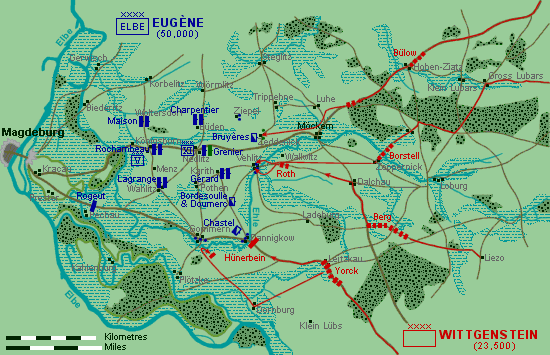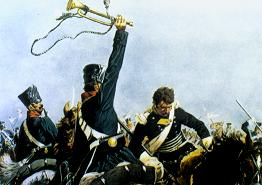The Combat of Möckern
5th April 1813
Deployment
Eugène deployed his forces in two lines. The first line, formed by XI Corps, had Charpentier's division in Büden, Grenier's[2] in Nedlitz and Gérard's in Karith. The second line was formed by V Corps, with Maison's division in Woltersdorf, Rochambeau's in Königsborn and Lagrane's in Wahlitz. The Kluss Damm causeway into Magdeburg was guarded by Rogeut's Imperial Guard division in Pechau. The front of this position was screened by Latour-Maubourg's cavalry corps, whilst infantry detachments occupied Gommern, Dannigkow, Vehlitz, Zeddenick and Ziepel[3].

The Prussians attacked in four converging columns. In the north, moving along the Berlin road, was Bülow's corps; Borstell advanced from Gloina (off map) through Gross Lubars and Zeppernick; Berg's Russian division advanced from Liezo through Dalchau and finally Yorck moved up the main road from Zerbst (off map) towards Dannigkow. The above map shows the positions of these forces at around 4pm.
The scattered nature of these columns, and of Eugène's defenders led to three seperate skirmishes taking place...
Dannigkow
This village was garrisoned by two companies of the 154th Infantry, drawn from Lagrange's division, and two squadrons of cavalry. In support, the bulk (such as it was) of Latour-Maubourg's cavalry corps was deployed behind the village. Yorck's advanced guard, commanded by Generalmajor von Hünerbein, advanced up the road from Leitzkau. The French cavalry engaged the 2nd Leib-Hussar regiment, but were driven off; the Prussian pursuit was halted by skirmishing fire from Dannigkow.
An infantry assault on the village was repulsed by the French, now reinforced by the grenadier company of the 154th. An attempt to outflank the French by the Fus/1st East Prussian regiment was turned back at Gommern. This dogged defence depleted the garrison's ammunition such that a second assault led by Prussian Major Lobenthal succeeded in pushing them back towards Gommern. However, as the Prussians emerged on the western side of the village, they were attacked by the 1st and 3rd Cuirassier divisions causing them to fall back and allow the French to reoccupy the village.
Finally, Yorck's main body began to arrive on the battlefield. He deployed his guns and bombarded the enemy, but the increasing darkness prevented any further attacks being made.
Vehlitz
Vehlitz was initially occupied by four companies of infantry. Once alerted by the attack on Dannigkow, Eugène bolstered this force by having Grenier send the 1/112th Line and two 6pdrs into the village. General Zucchi also contributed a battalion to the defence, probably one from the 5th Italian Line.
The allied attack combined Borstell's Prussian column with the advanced guard of Berg's Russians (which was commanded by General Roth). It was carried out in three columns: on the left, the Fus/4th East Prussian infantry and the Pomeranian Grenadiers attacked the village from the south; in the centre were Roth's Russians whilst on the right two battalions of the 2nd Pomeranian Infantry struck the north side of the village. Faced by this triple onslaught, the French abandoned the left bank of the Ehle and fell back to the bridge. The Prussians pressed on, fording the river (which was only 3 feet deep) and spiking the French cannon before their cavalry once more intervened. Troopers from Chastel's 3rd Light Cavalry Division swept in on the advancing Prussians, forcing the southern column back and the northern one into square. However, a counter-attack by the Grodno Hussars and the Königin Dragoons sent the French packing and Vehlitz fell into allied hands.
With Vehlitz as a base, the allies continued the assault on 35th Division; an attack by 1/1st Pomeranian Infantry, the Pomeranian Grenadiers and the Russian 26th Jägers capturing a French cannon. The French were falling back in good order as night brought hostilities to an end.
Zeddenick
Bülow's column moved down the Berlin road into Möckern, headed by a cavalry and artillery force under General Oppen. The garrison - two companies of the 3rd battalion, 2nd Italian Light - withdrew towards Zeddenick, where they met General Zucchi advancing with the rest of the battalion and the regimental artillery company. Zucchi thus found himself in charge of ten companies of infantry (the Italian battalion having been joined by four French companies that had been defending Zeddenick) and two 4pdr cannon supported by Bruyères' light cavalry division. Facing him was Oppen's force of two cavalry regiments and a horse battery, together with the Illowaisky IV cossacks from Berg's column (who had joined them at Hohen-Ziatz); Bülow was moving up behind with the main body.
 The outnumbered French cavalry was soon driven off, but not
before a curious incident took place that achieved some notoriety at
the time. During the cavalry skirmishing, Major "Crazy" Platen of the
Lithuanian Dragoons was attacked and wounded by a French lancer.
Slashing back with his sabre, Platen returned the compliment but failed
to unhorse the Frenchman. The coup-de-grace was delivered by Platen's
trumpeter with a deft swing of his instrument!
The outnumbered French cavalry was soon driven off, but not
before a curious incident took place that achieved some notoriety at
the time. During the cavalry skirmishing, Major "Crazy" Platen of the
Lithuanian Dragoons was attacked and wounded by a French lancer.
Slashing back with his sabre, Platen returned the compliment but failed
to unhorse the Frenchman. The coup-de-grace was delivered by Platen's
trumpeter with a deft swing of his instrument!
Zucchi initially tried to retake Zeddenick, but outnumbered and outgunned by the Prussians he found it impossible to do so. Instead, he formed his infantry into three small squares and began a careful withdrawal. Stopping to beat off allied cavalry charges and under a withering fire from their horse artillery, Zucchi's force fell back towards Nedlitz. At one point, as he was waiting to allow his guns through a defile, the Prussians called on him to surrender - but they were rebuffed. The embattled force finally reached Nedlitz at 7pm, by which time darkness had brought an end to the fighting.
